When Laos’ Lan Xang kingdom’s political power peaked in the 16th and 17th centuries, it was one of the main states in mainland Southeast Asia.
Its kings built monasteries and coordinated Buddhist and court rituals. Monks and ornate assembly halls became common symbols for the world’s order.
As in many other Southeast Asian states, stories in the Ramayana became the subjects for elegant dances at court. The children in the above photo attest that this is still a living tradition–and very pleasant to watch.
So when ancient Laos became a large state, its royals used ideas and arts from India to help unify itself. Khmers and states in Thailand, Burma and Indonesia did too. But all these kingdoms added as much inspiration from their own traditions. Every country is a cultural feast, so here we’ll get in step with the Laotian variety.
My article on Ancient Laos Part One explains that Buddhist monasteries and stupas were built, rituals were established and scriptures were translated. These are the things that you’d expect kings to do when they wanted to consolidate their power with the growing faith.
But Laos’ own cultural wealth quickly grew into the patterns from India:
1. The Ramayana was translated as the Phra Lak Phra Lam, which was modified to fit Laotian contexts. John Clifford Holt, in Spirits of the Place, wrote that the Laotian version focused less on the Sanskrit epic’s sweeping perspectives, and was more centered on the immediate family. Instead of the vast metaphysical background of the dharma which royal power’s supposed to be based on, the Phra Lak Phra Lam focuses more on how to arrange marriage proposals and conduct familial relations.
Holt felt that this is because Lan Xang’s kings married into other Thai states to give themselves more diplomatic clout. If Keith Ferazzi, who wrote a business networking book called Never Eat Alone, had lived in Lan Xang, he might have written Never Sleep Alone. The Phra Lak Phra Lam portrayed the hero, Rama, as the heir to Lan Xang’s throne. He exemplified Buddhist merit and royal etiquette.
But theater was staged in towns and villages too. Like all Tai ethnic groups, Lao had been living in cozy riverine valleys and uplands, in small communities that stressed harmony with nature and its spirits. Their epic’s focus on the family resonated more than the vast cosmic landscape in the Indian versions did.
2. Monks in Luang Prabang translated another huge literary tradition from India and Sri Lanka–the Jatakas. They were stories of more than 500 of the Buddha’s past incarnations. Luang Prabang’s kings especially focused on the Vessantara Jataka, which was about the last reincarnation before the historic Buddha. The above photo is of an illustration of it inside Wat Xieng Thong’s public assembly hall. Vessantara was a prince who gave away everything he owned. In Thai traditions, each of the most popular Jatakas illustrated one of the Buddha’s virtues (parami). The Vessantara story exemplefied his generosity.
Holt says that the Vessantara Jataka was ritually recited in wats all over Laos every year and that this ceremony became the most important occasion for merit making. Though the story’s more ideal than real–Lao and Thai kings often battled each other and their own lords–the focus on giving resonated with ordinary Laotians. The Vessantara story brought the vast perspectives in Indian texts down to the cozy village.
3. Buddhist and Hindu cosmologies saw Mount Meru as the center of the world, and many Southeast Asian cultures transposed this idea to their own lands. Khmers saw Angkor Wat as a model of Meru, and the Thai Sukhothai kingdom probably saw its Wat Mahathat in the same terms. A hill in the middle of Luang Prabang called Phousi (above) rises in the center of town. The royal palace is in the bottom right of the picture, so it was built at its foot. Ideas inspired by the vast Himalayas were thus grafted onto Luang Prabang’s environment of undulating hills and rivers, and tropical monsoons. The locals retained their geography of serpants who protected different regions of Luang Prabang.
So every major idea and tradition that was imported from India blended with Lao cultural patterns. India’s vast panoramas were balanced by the centrality of the local world of the family and village. And ideas that reflected the enormity of India’s natural environment fused with the Lao worlds of narrow riverine valleys. You can’t reduce Laos to one system. Lan Xang’s kings tried to unify their realm with ideas from India, but in the process they added yet more variety to their inherantly irreducible land.
In the next post, we’ll discover vareity that the kings tried to expel. Laos’ land and people have too much spirit to be constrained.

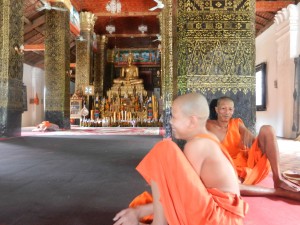
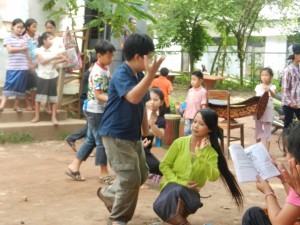
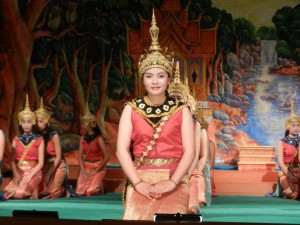
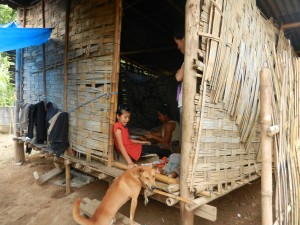
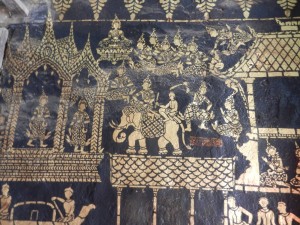
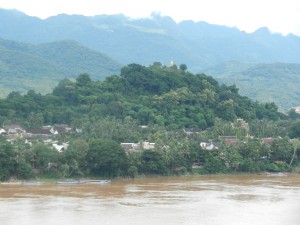
Comments on this entry are closed.